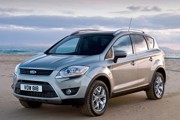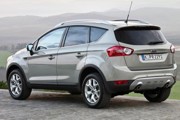Review
Ford has gone to a lot of trouble to get the new Kuga SUV right.
Its design team has spent hours in the studio imbuing the Kuga with a mix of sexiness and butchdom, while engineers have been burning the midnight oil ensuring it drives well and has class-leading emissions and economy figures.
Which is all well and good, but slightly irrelevant, as you probably won’t be able to get your hands on one this year.
Ford has roughly 7,000 models to sell in the UK annually, and you can be sure that the majority of this year’s supply has already been snapped up.
Which means that drivers looking at a small SUV will probably be denied the pinnacle of the breed, because the Kuga ticks every box.
Firstly, the styling, which is all-important in this trend-driven sector.
The Kuga just looks right, with some softer lines blending into masculine haunches. It’s chunky and sexy, making it appeal to both male and female drivers.
Secondly, the clever stuff under the bonnet.
The Kuga is offered with one engine option, the familiar 2.0 TDCi diesel, offering 133bhp.
This returns a class-leading claimed combined economy figure of 44.1mpg, along with lowest-in-class CO2 emissions of 169g/km.
Not bad for a chunky four-wheel drive car.
There’s a similarly sparse choice when it comes to trim levels, too, with Ford deciding that Zetec and Titanium will suffice.
I agree, as it makes choosing a model much easier than ploughing through nine pages of a brochure trying to compare kit levels.
The Zetec trim on test gives you keyless ignition (a pointless feature as the key has to live somewhere anyway), 17-inch alloy wheels, air conditioning, ESP, ABS brakes and the Easyfuel system to stop a driver putting petrol into the tank.
Titanium trim adds, among other items, rain-sensing wipers, automatic headlights and part-leather trim.
Both models come with a dual split tailgate, just like the old Range Rover, which allows items to be dropped in by just opening the glass area of the tailgate.
There are also myriad storage areas, including a large chunk of space under the rear seat bench.
All very impressive – and so is the Kuga on the road.
To say it drives like a Focus is pushing it a bit, but it really isn’t that far removed.
The greater ride height gives a commanding view of the road, yet the Kuga handles sharply and smoothly.
The diesel engine and six-speed manual gearbox are ideal partners for the car, with plenty of torque low down the rev range.
The diesel is also quiet at idle.
As an all-round package, the Kuga has got it aced. It’s just a shame there are so few coming to the UK each year.
Positive points:
* Striking looks
* Decent drive
* Running costs
* Tax bill
Negative:
* Plasticky interior
* Limited supply
THREE RIVALS TO CONSIDER
* Honda CR-V 2.2 i-CTDi SE
* Vauxhall Antara 2.0 CDTi E
* Volkswagen Tiguan 2.0 TDI S
P11D PRICE
All four models are in entry-level trim, and cost within £800 of each other.
The Honda offers 138bhp and is well equipped, making it look good value at the front end.
The Volkswagen and Ford are closely matched, while the Vauxhall is easily the most expensive.
CR-V: £20,065
Tiguan: £20,245
Kuga: £20,275
Antara: £20,840
EMISSIONS AND TAX RATES
The Ford and Honda lead the way here, costing a 40% taxpayer £162 and £167 a month respectively in benefit-in-kind tax.
The Volkswagen is third on £182 a month while the Vauxhall is a distant fourth.
Its high emissions mean a monthly BIK bill of £208 for the same driver.
Kuga: 169g/km/24%
CR-V: 173g/km/25%
Tiguan: 182g/km/27%
Antara: 198g/km/30%
SMR COST
Variable service intervals help the Volkswagen to top spot in the service, maintenance and repair section, with the Tiguan expected to cost £1,932 over three years/60,000 miles.
Both the Ford and Honda require attention at a dealership every 12,500 miles and are very evenly matched.
ppm/60k total
Tiguan: 3.22/£1,932
Kuga: 4.08/£2,448
CR-V: 4.09/£2,454
Antara: 5.20/£3,120
FUEL COST
Ford claims the Kuga will return 44.1mpg on the combined cycle, which equates to a diesel spend of nearly £7,200 over 60,000 miles.
The Honda, on 43.5mpg, is second, with a likely cost of £7,284.
The Volkswagen scrapes over the 40mpg mark.
The Vauxhall returns 37.2mpg.
ppm/60k total
Kuga: 11.97/£7,182
CR-V: 12.14/£7,284
Tiguan: 12.91/£7,746
Antara: 14.20/£8,520
DEPRECIATION COST
The Volkswagen leads the way, with CAP estimating the Tiguan will retain 46% of its cost new after three years/60,000 miles.
Second goes to the Kuga. Its RV of 45% is excellent for the sector, and barnstorming for a Ford.
The Honda retains 43% and the Antara 38%.
ppm/60k total
Tiguan: 17.95/£10,770
Kuga: 18.33/£10,998
CR-V: 18.60/£11,160
Antara: 21.10/£12,660
WHOLELIFE COST
The Volkswagen and Ford are closely matched, with around £170 separating them over three years/ 60,000 miles.
The Kuga scores highly in all sectors, whereas the Tiguan’s better RV performance sneaks the win despite a slightly higher fuel price.
ppm/60k total
Tiguan: 34.08/£20,448
Kuga: 34.38/£20,628
CR-V: 34.83/£20,898
Antara: 40.50/£24,300
VERDICT
This is a three-horse race, with the Vauxhall being the first to be dropped.
The Antara simply isn’t in the same league as the others and costs much more to run and in tax than the rest.
The CR-V has been around for a while now, so we’ll drop it from the reckoning as this is such a fashion conscious sector.
However, it is still a very good car and stacks up well on running costs. So, it’s down to the Volkswagen and Ford.
Both are great cars, both perform well on wholelife costs, but the Kuga sneaks the victory because it offers a lower monthly BIK bill for drivers.
* WINNER: Ford Kuga 2.0 TDCi Zetec















Login to comment
Comments
No comments have been made yet.